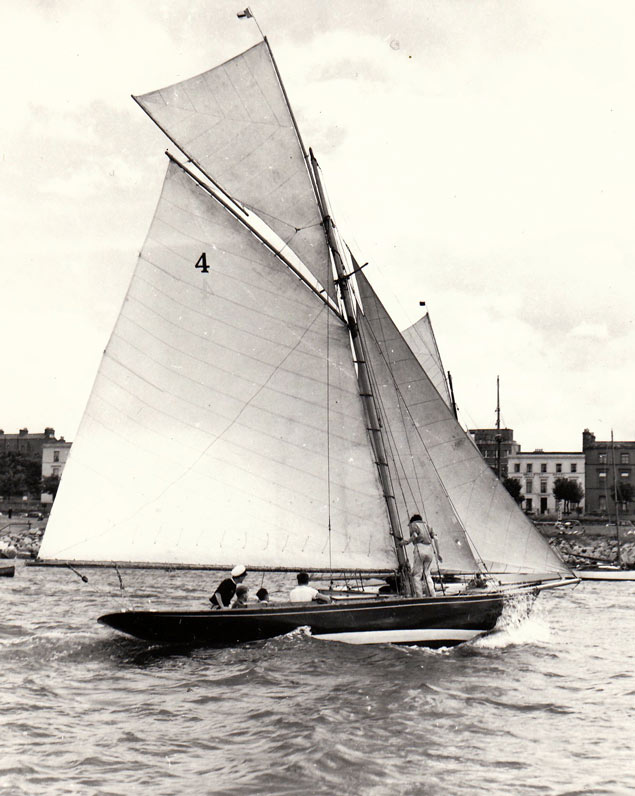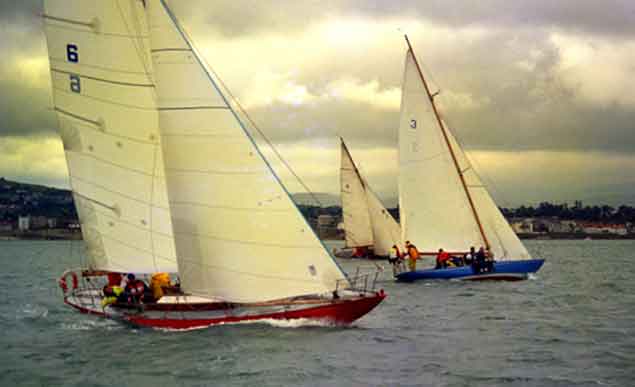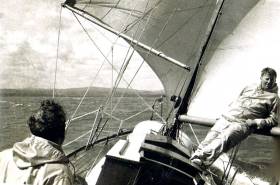Displaying items by tag: Cas Smullen
John D “Cas” Smullen 1930-2017
With his death at the age of 87, the loss of Cas Smullen deprives Irish sailing of a total enthusiast whose dedication to our sport was central to his entire existence. Such was his exuberant enjoyment of sailing that one of his many skippers remarked that, if your own delight in sailing was wilting in any way, you only had to spend a few days afloat in Cas’s company to find the flame of your personal enthusiasm being re-kindled with full vigour.
While his last ten years were restricted by illness and the ongoing effects of a stroke in 2007, his brain was sharp to the end, and he continued to enjoy convivial visits to his beloved National Yacht Club in Dun Laoghaire, where his membership was a record-breaking 71 years.
Although he wasn’t from a sailing family, in his youth he attracted the sailing community’s attention through his prowess as a swimmer, both in the harbour and as a star at Blackrock Baths, where he was a regular and stylish performer off the top diving board. Skippers looking for able-bodied young men for crewing duties in the Dun Laoghaire fleet rightly reckoned that young Smullen might have what it takes, and by the time he was 16, he was an active regular in a sport which fitted him like a glove.
So popular was he as a crew - and often in effect the skipper - that in his long sailing career, he never personally owned a boat. The nearest he came to it was when he built a Mirror dinghy for his son Johnny, who has since gone on to become the California-based classic yacht-builder to America’s Cup legend Dennis Conner, so the effects of that one experience have carried further than anyone could have imagined.
 A Dublin Bay 21 in all her gaff-rigged finery. The class was contemplating changing to Bermudan rig in 1963 “to save time”, but Cas Smullen reckoned he could rig one single-handed in less than 15 minutes. The class challenged him to put on a display at the National YC, while they watched. He did it in nine minutes.
A Dublin Bay 21 in all her gaff-rigged finery. The class was contemplating changing to Bermudan rig in 1963 “to save time”, but Cas Smullen reckoned he could rig one single-handed in less than 15 minutes. The class challenged him to put on a display at the National YC, while they watched. He did it in nine minutes.
Cas Smullen was the quintessential Dublin Bay yachtsman, as his entire working life was spent as an insurance broker. This gave his day-to-day life a regularity which is unknown to many in today’s more restless working environment. For weeks on end – if he wasn’t away cruising or on some offshore racing campaign – he would invariably be racing without fail in the Dublin Bay SC fleet every Thursday evening, and again every Saturday afternoon.
It would take a substantial book to record all his cruises, as he became a member of the Irish Cruising Club in 1961. As for offshore racing, as a longtime member of the Royal Ocean Racing Club, he was fully into it at every level including sailing as a member of the Irish Admiral’s Cup team in 1969. But even with all those experiences, it was Dublin Bay sailing which was at the core of his sailing way of life, and he was a particular devotee of the Dublin Bay 21 Class, and then of the Dublin Bay 24 Class, especially noted for his skill in getting the best out of boats when racing in light airs.
He was in the heart of the Dublin Bay 21s in 1962-63 when the owners debated changing them from their demanding jackyard topsail-setting cutter gaff rig to a more easily-handled Bermudan sloop. On hearing that one of the reasons they wanted to change was that the boats could be more quickly rigged for racing, he claimed that this was nonsense. He said it didn’t take more than 15 minutes to rig them single-handed, and he would show them how, just to prove it.
The story has come down the ages that one of the Dublin Bay 21s was brought in close to the National YC with all sails harbour-stowed, and an audience gathered on the balcony, drinks in hand, to watch Cas Smullen rig the boat in a quarter of an hour. The word was that he achieved it with style, but they went ahead and changed to Bermuda rig anyway.
 The Johnston family’s Dublin Bay 24 Harmony racing in the Dublin Bay Woodenboat Regatta of 1997 with Cas Smullen on board. Photo: W M Nixon
The Johnston family’s Dublin Bay 24 Harmony racing in the Dublin Bay Woodenboat Regatta of 1997 with Cas Smullen on board. Photo: W M Nixon
We recounted that story again recently on Afloat.ie, and his daughter Jean – the nationally-known wine expert – took her laptop into the hospital to read it to him. He much enjoyed it, but with eyes sparkling despite his infirmity, he firmly insisted on one correction. It was actually all done in nine minutes - not fifteen. We are more than happy to take this opportunity to put the record straight on that point in the definitive Cas Smullen story. In extending our heartfelt condolences to his family in their loss of this unique, great and much-loved character, it is in the knowledge that the world of Irish sailing has been a better and more interesting place for having had Cas Smullen in the heart of it.
WMN





























































